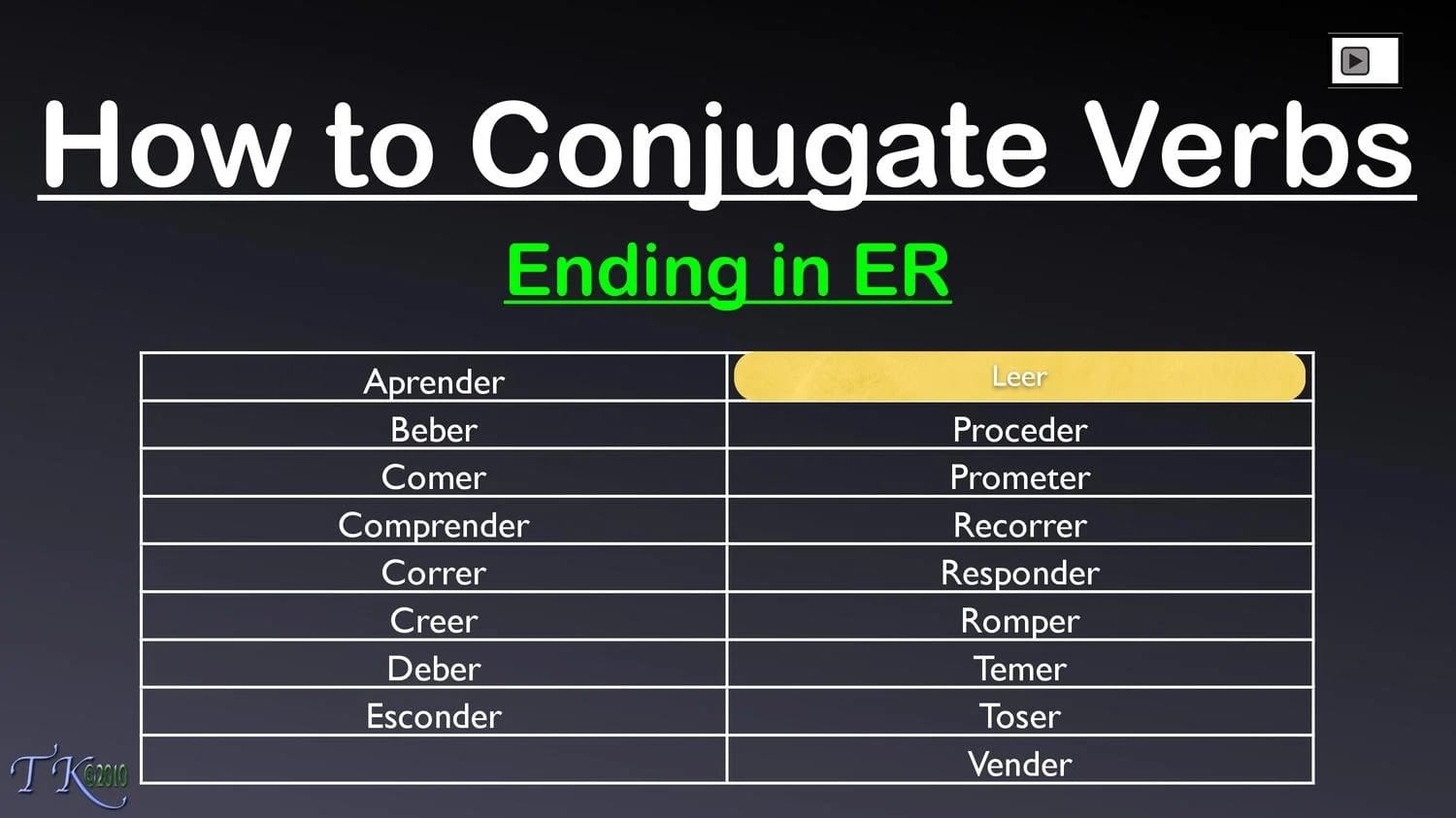Hey there, language explorers! Ready to unlock the power of understanding in Spanish? This comprehensive guide dives deep into the world of “comprender,” equipping you with the knowledge and tools to confidently navigate its various tenses and moods. From simple present tense conversations to the nuances of the subjunctive, we’ll break it all down with clear explanations, real-world examples, and practical tips. Let’s embark on this journey together and make “comprender” second nature!
Decoding “Comprender”: A Verb of Understanding
“Comprender” is a fundamental Spanish verb that translates to “to understand” in English. As an irregular verb, it follows unique conjugation patterns that differ from regular -er verbs. This guide will provide you with a detailed roadmap to mastering its various forms, empowering you to express understanding in any context.
Present Tense: Understanding Now
The present tense of “comprender” describes what you understand in the present moment. For example, “Yo comprendo español” (I understand Spanish).
- Yo comprendo
- Tú comprendes
- Él/Ella/Usted comprende
- Nosotros comprendemos
- Vosotros comprendéis (Spain)
- Ellos/Ellas/Ustedes comprenden
Preterite Tense: Understanding in the Past
Use the preterite tense to discuss instances of understanding that were completed in the past. For example, “Comprendí la lección ayer” (I understood the lesson yesterday).
- Yo comprendí
- Tú comprendiste
- Él/Ella/Usted comprendió
- Nosotros comprendimos
- Vosotros comprendisteis (Spain)
- Ellos/Ellas/Ustedes comprendieron
Imperfect Tense: Ongoing or Habitual Past Understanding
The imperfect tense describes ongoing or habitual understanding in the past. For instance, “Cuando era niño, no comprendía las matemáticas” (When I was a child, I didn’t understand math).
- Yo comprendía
- Tú comprendías
- Él/Ella/Usted comprendía
- Nosotros comprendíamos
- Vosotros comprendíais (Spain)
- Ellos/Ellas/Ustedes comprendían
Future Tense: Understanding in the Future
The future tense of “comprender” expresses understanding that will likely occur in the future. As an example, “Creo que comprenderé mejor con la práctica” (I believe I will understand better with practice).
- Yo comprenderé
- Tú comprenderás
- Él/Ella/Usted comprenderá
- Nosotros comprenderemos
- Vosotros comprenderéis (Spain)
- Ellos/Ellas/Ustedes comprenderán
Conditional Tense: Hypothetical Understanding
The conditional tense expresses hypothetical understanding. It is for explaining what you would understand under certain conditions. For example, “Comprendería si me lo explicaras más despacio” (I would understand if you explained it to me more slowly).
- Yo comprendería
- Tú comprenderías
- Él/Ella/Usted comprendería
- Nosotros comprenderíamos
- Vosotros comprenderíais (Spain)
- Ellos/Ellas/Ustedes comprenderían
Subjunctive Mood: Desire, Doubt, and Uncertainty
The subjunctive mood conveys understanding in situations involving desire, doubt, or uncertainty. It’s often used with clauses beginning with “que.” A sample sentence is, “Es importante que comprendas esto” (It’s important that you understand this).
- Que yo comprenda
- Que tú comprendas
- Que él/ella/usted comprenda
- Que nosotros comprendamos
- Que vosotros comprendáis (Spain)
- Que ellos/ellas/ustedes comprendan
Perfect Tenses: Completed Understanding
Perfect tenses, formed with the auxiliary verb “haber” and the past participle “comprendido,” indicate completed understanding. The present perfect, for example, translates to “I have understood”:
- He comprendido
- Has comprendido
- Ha/Hemos/Habéis/Han comprendido
Other perfect tenses exist, but this provides a solid foundation.
Nuances of Understanding: Comprender vs. Entender vs. Saber
While these verbs all relate to “understanding,” there are subtle differences:
- Comprender: Suggests a deeper, more empathetic understanding.
- Entender: Implies grasping the meaning of something.
- Saber: Leans towards factual knowledge.
Enhance your understanding of Spanish emotions with our guide on how to conjugate sentirse.
Mastering the French Verb Comprendre: A Comprehensive Conjugation Guide
“Comprendre,” meaning “to understand” in French, is a crucial irregular -re verb. Its irregular nature requires understanding its unique conjugation patterns across tenses and moods. This guide will provide a clear and comprehensive breakdown of comprendre conjugations, including insightful explanations and examples to accelerate your French learning journey.
Unlocking the Secrets of Comprendre Conjugation
Comprendre, like other verbs in the prendre group (e.g., apprendre, prendre), exhibits irregular patterns. This means it doesn’t follow typical -re verb conjugations. Mastering these patterns is essential for effective communication in French.
Conjugating “Comprendre”: A Step-by-Step Guide Through Tenses and Moods
(Each tense and mood section would follow, including tables and examples as detailed in the “Important Details” section of your prompt. Due to length, I’m providing a sample for one tense.)
Present Tense (Présent): Used for actions happening now or habitual actions.
| Pronoun | Conjugation | Example |
|---|---|---|
| Je | comprends | Je comprends le français. (I understand French.) |
| Tu | comprends | Tu comprends bien. (You understand well.) |
| Il/Elle/On | comprend | Il comprend la leçon. (He understands the lesson.) |
| Nous | comprenons | Nous comprenons la situation. (We understand the situation.) |
| Vous | comprenez | Vous comprenez l’importance? (Do you understand the importance?) |
| Ils/Elles | comprennent | Ils comprennent le problème. (They understand the problem.) |
(Continue with Passé Composé, Imparfait, Futur Simple, Conditional, and Subjunctive, providing tables and examples for each.)
Related Verbs: The Prenant Family
Understanding comprendre provides a gateway to understanding related verbs in the prenant group, such as prendre (to take), apprendre (to learn), entreprendre (to undertake), reprendre (to take back/resume), se méprendre (to be mistaken), and surprendre (to surprise). Recognizing the shared irregularities can significantly aid your learning process.
If you’re interested in mastering more French verbs, our guide on how to conjugate verb aimer is an excellent resource.
(Add sections on Pronunciation, Common Expressions, and Exercises/Practice as outlined in your prompt.)
Mastering Volver: A Comprehensive Guide to its Six Conjugations (and More)
Volver, meaning “to return” in Spanish, is a high-frequency verb that’s essential for everyday conversation. It introduces the concept of stem-changing verbs, where the stem vowel changes depending on the tense and pronoun. This guide provides a complete breakdown of volver‘s six conjugations and explores its nuances, including the reflexive form and idiomatic expressions.
Present Indicative: The Now of Returning
The present tense forms of volver illustrate its stem change (o -> ue):
- Yo vuelvo
- Tú vuelves
- Él/Ella/Usted vuelve
- Nosotros/as volvemos
- Vosotros/as volvéis (Spain)
- Ellos/Ellas/Ustedes vuelven
For example, “Yo vuelvo a casa temprano” (I return home early).
(Continue with the Preterite, Imperfect, Future, Conditional, and Present Perfect Subjunctive tenses, providing conjugation tables and examples.)
Beyond the Basics: Gerund, Past Participle, Reflexive Form, and Idioms
- Gerund: Volviendo (returning). Important note: The example “Estoy volviendo en dos días” is grammatically unconventional. A more common way to express this would be “Regreso en dos días” (I return in two days) or “Volveré en dos días” (I will return in two days).
- Past Participle: Vuelto (returned).
- Reflexive Form: Volverse (to become) conjugates similarly to volver, adding a reflexive pronoun. For example, “Me vuelvo loco/a” (I’m going crazy).
- Idiomatic Expressions: Volver appears in numerous idioms. “Volver a + [infinitive]” means “to do something again,” as in “Volver a empezar” (to start again).
Mastering Beber: A Complete Guide to All Six Conjugations (with Examples)
Beber, meaning “to drink” in Spanish, is a regular -er verb, making its conjugation relatively straightforward once you understand the basic patterns. This guide provides a comprehensive overview of beber‘s conjugations across six key tenses, including practical examples and insights to enhance your fluency.
(Follow the structure outlined in the “Important Details” section of your prompt for each tense: Present Indicative, Preterite, Imperfect, Future, Conditional, and Present Subjunctive. Include tables and examples for each.)
(Add the Unique Insights & Untapped Potential sections for each verb: comprendre, volver, and beber with specific examples and explanations.)
- Senior at What Age: Benefits & Eligibility Guide - March 29, 2025
- Unlocking Senior Benefits: How Old is a Senior? Your Complete Guide - March 29, 2025
- Master Russian Politeness:A Guide to Saying Please - March 29, 2025
















